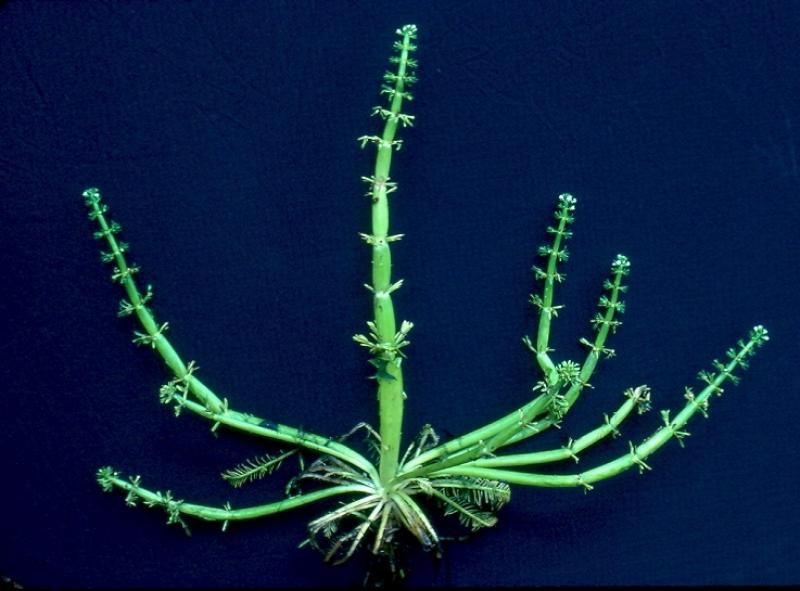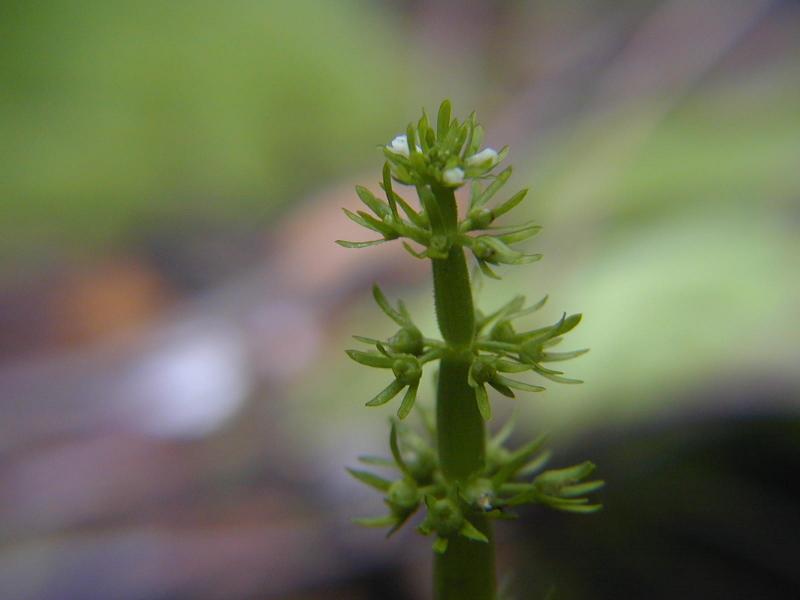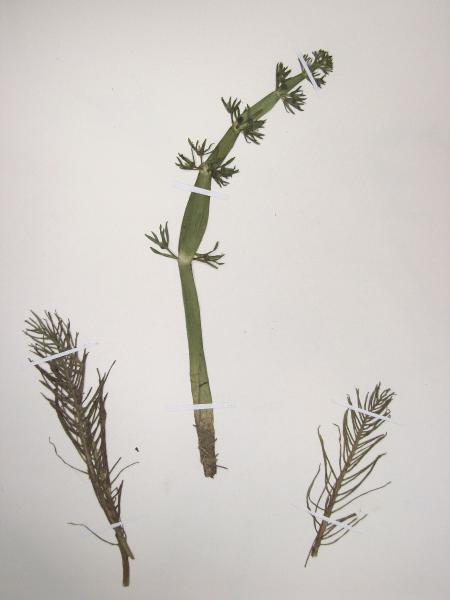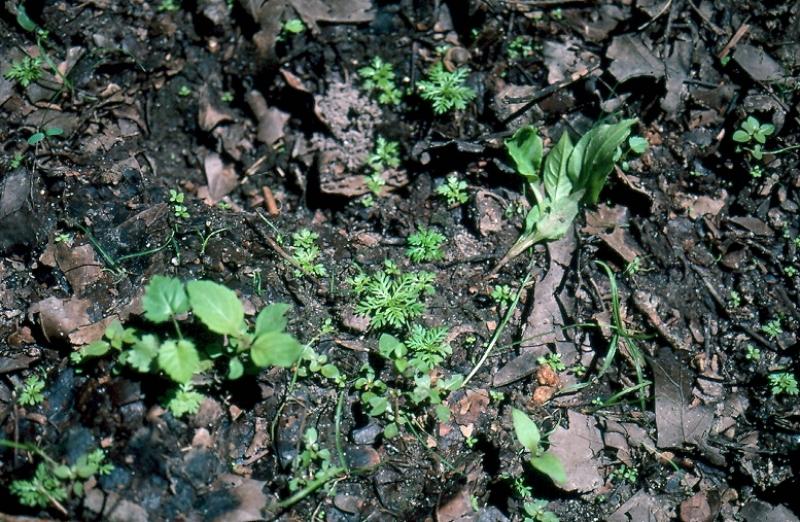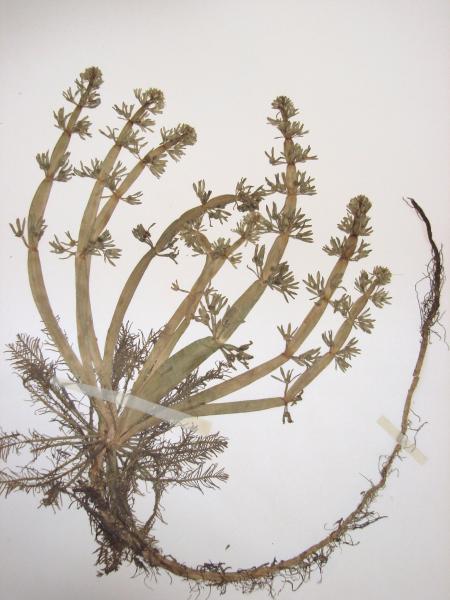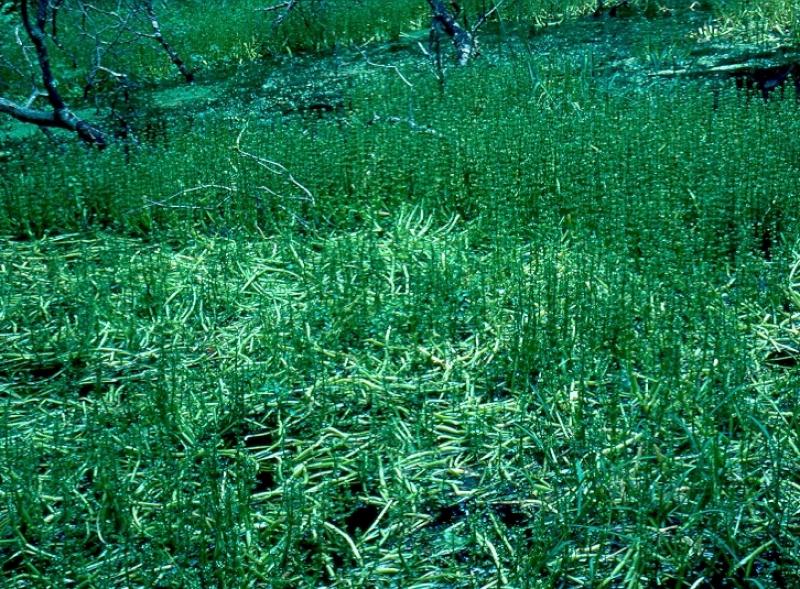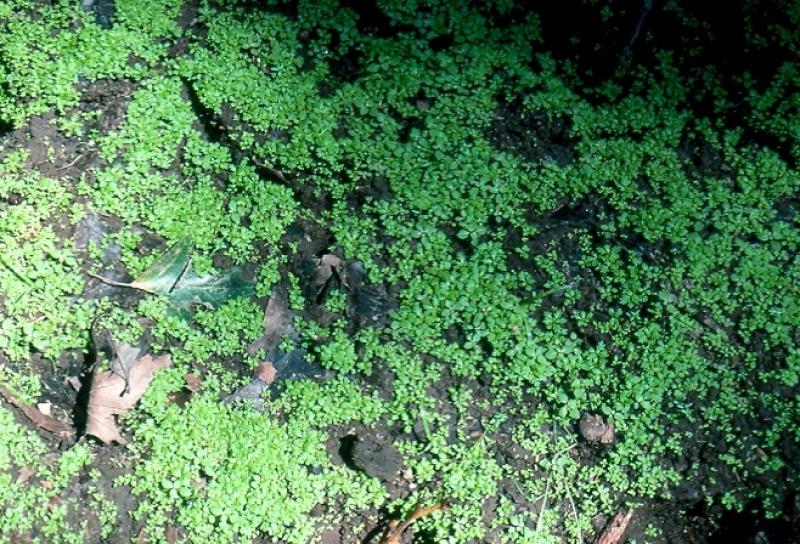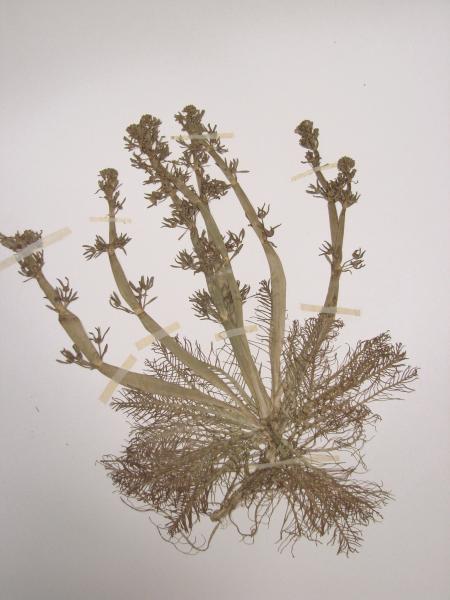American Featherfoil
Hottonia inflata Ell.
- Class
- Dicotyledoneae (Dicots)
- Family
- Primulaceae (Primrose Family)
- State Protection
- Threatened
Listed as Threatened by New York State: likely to become Endangered in the foreseeable future. For animals, taking, importation, transportation, or possession is prohibited, except under license or permit. For plants, removal or damage without the consent of the landowner is prohibited.
- Federal Protection
- Not Listed
- State Conservation Status Rank
- S2
Imperiled in New York - Very vulnerable to disappearing from New York due to rarity or other factors; typically 6 to 20 populations or locations in New York, very few individuals, very restricted range, few remaining acres (or miles of stream), and/or steep declines.
- Global Conservation Status Rank
- G4
Apparently Secure globally - Uncommon in the world but not rare; usually widespread, but may be rare in some parts of its range; possibly some cause for long-term concern due to declines or other factors.
Summary
Did you know?
Now you see it, now you don't. Featherfoil may appear in great numbers in a pond in one year and be absent for one or many years after that. That may be due to its two-year life cycle or the washing away and reintroduction of seeds. Ducks and beaver seem to be most responsible for spreading the seeds around. The genus was named by Linnaeus for Petrus Hotton (1648-1709), a professor of medicine and botany at Leiden, Holland. The species name refers to the inflated stems that help it float.
State Ranking Justification
There are 14 existing populations but only four of these have sizable numbers. Most populations consist of fewer than 100 plants and need more surveys to determine if they still exist. There are 12 historical occurrences, some of which are considered extirpated.
Short-term Trends
Short-term trend seems to be stable, especially with larger populations. Small populations have less of a chance of being seen every year. There is little evidence in New York that populations have large fluctuations from year-to-year.
Long-term Trends
There has been some decrease in populations on Western Long Island and Staten Island but more populations have been found further north into Westchester and Orange counties. Population numbers have been around 10 to 15 populations in the state over the last 100 years. There is little room for expansion in the ponds of Long Island but if climate warms it may find more suitable habitat in upstate New York and expand its range and numbers.
Conservation and Management
Threats
The small unprotected ponds and vernal pools are threatened by habitat development and invasion by Japanese silver grass (Microstegium). The water levels of some of the wetlands may be affected by nearby development.
Conservation Strategies and Management Practices
The water bodies where these plants grow need to be protected and buffers established to prevent hydrologic changes and direct development impacts.
Research Needs
More research is needed about its habitat preference. There are many wetlands that are of adequate size for this species to grow but it only occurs in a small proportion of these. Management techniques also need to be studied to discover the best way to preserve and augment populations.
Habitat
Habitat
In New York Featherfoil has been found in kettle ponds, vernal pools, coastal swales, and ponded portions of small streams. More habitat data are needed for many of the known occurrences (New York Natural Heritage Program 2007). Pools and ditches (Fernald 1970). Quiet shallow water or occasionally in wet soil, chiefly on the coastal plain (Gleason and Cronquist 1991).
Associated Ecological Communities
- Coastal plain pond
(guide)
The aquatic community of the permanently flooded portion of a coastal plain pond with seasonally, and annually fluctuating water levels. These are shallow, groundwater-fed ponds that occur in kettle-holes or shallow depressions in the outwash plains south of the terminal moraines of Long Island, and New England. A series of coastal plain ponds are often hydrologically connected, either by groundwater, or sometimes by surface flow in a small coastal plain stream.
- Deep emergent marsh
(guide)
A marsh community flooded by waters that are not subject to violent wave action. Water depths can range from 6 in to 6.6 ft (15 cm to 2 m). Water levels may fluctuate seasonally, but the substrate is rarely dry, and there is usually standing water in the fall.
- Pine barrens vernal pond
(guide)
A seasonally fluctuating pond and its associated wetlands that typically occurs in pine barrens. The water is intermittent, usually a pond in the spring but sometimes losing water through the summer to become a mostly vegetated wetland at the end of the summer. These ponds and wetlands may be small.
- Shallow emergent marsh
(guide)
A marsh meadow community that occurs on soils that are permanently saturated and seasonally flooded. This marsh is better drained than a deep emergent marsh; water depths may range from 6 in to 3.3 ft (15 cm to 1 m) during flood stages, but the water level usually drops by mid to late summer and the soil is exposed during an average year.
- Shrub swamp
(guide)
An inland wetland dominated by tall shrubs that occurs along the shore of a lake or river, in a wet depression or valley not associated with lakes, or as a transition zone between a marsh, fen, or bog and a swamp or upland community. Shrub swamps are very common and quite variable.
- Vernal pool
(guide)
An aquatic community of one or more intermittently ponded, small, shallow depressions typically within an upland forest. Vernal pools are typically flooded in spring or after a heavy rainfall, but are usually dry during summer. Substrate is typically dense leaf litter over hydric soils. Vernal pools typically occupy a confined basin (i.e., a standing waterbody without a flowing outlet), but may have an intermittent stream flowing out of it during high water. This community includes a diverse group of invertebrates and amphibians that depend upon temporary pools as breeding habitat. These include amphibians, reptiles, crustaceans, mollusks, annelids, and insects.
Associated Species
- Acer rubrum
- Callitriche hermaphroditica (autumn water-starwort)
- Carex brunnescens (brownish sedge)
- Carex comosa (bristly sedge)
- Carex scoparia (pointed broom sedge)
- Carex stricta (tussock sedge)
- Cephalanthus occidentalis (buttonbush)
- Ceratophyllum demersum (common coon-tail)
- Clethra alnifolia (coastal sweet-pepperbush)
- Cornus amomum
- Decodon verticillatus (water-willow)
- Glyceria canadensis (rattlesnake manna grass)
- Microstegium vimineum (Japanese stilt grass)
- Nuphar advena
- Persicaria amphibia
- Persicaria hydropiperoides (mild water-pepper)
- Pontederia cordata (pickerelweed)
- Ranunculus flabellaris (yellow water butter-cup, yellow water crow-foot)
- Salix atrocinerea
- Sium suave (hemlock water-parsnip)
- Spiraea tomentosa (steeplebush)
- Tsuga canadensis (eastern hemlock)
- Vaccinium corymbosum (highbush blueberry)
Range
New York State Distribution
Featherfoil is known in New York only from the lower Hudson Valley (as far north as Orange County), New York City, and Long Island.
Global Distribution
Featherfoil is found along the Atlantic Coastal Plain from Maine to Florida, as well as in the Mississippi Valley from Louisiana, Texas, and Oklahoma north to Missouri, Illinois, Indiana and Ohio. It is a species of conservation concern in most of the states in which it is found. It is absent from Canada.
Identification Comments
General Description
Featherfoil is an aquatic herb, rooting in still, shallow water, with mostly submersed stems up to 50 cm long. Its leaves are dissected (feather-like) and crowded just beneath the floating flowering stalk. The flowers are white, the corolla 4-5 mm long, and emerge in groups of 3-10 at each node of the inflated flowering stalk.
Best Life Stage for Proper Identification
This species is sufficiently unique to be identified at any point during its life stage when the plant is readily visible, though it is most conspicuous when the floating flowering stalk is present.
Similar Species
Featherfoil's inflated, floating flowering stalk, bearing many tiny, white flowers, looks like nothing else.
Best Time to See
Featherfoil flowers from late May to early July, the fruits persisting into August.
- Vegetative
- Flowering
- Fruiting
The time of year you would expect to find American Featherfoil vegetative, flowering, and fruiting in New York.
American Featherfoil Images
Taxonomy
American Featherfoil
Hottonia inflata Ell.
- Kingdom Plantae
- Phylum Anthophyta
- Class Dicotyledoneae
(Dicots)
- Order Primulales
- Family Primulaceae (Primrose Family)
- Order Primulales
- Class Dicotyledoneae
(Dicots)
- Phylum Anthophyta
Additional Common Names
- Featherfoil
- Water-violet
Additional Resources
Best Identification Reference
Crow, Garrett E. and C. Barre Hellquist. 2000. Aquatic and Wetland Plants of Northeastern North America: A revised and enlarged edition of Norman C. Fassett's a Manual of Aquatic Plants. Volume One: Pteridophytes, Gymnosperms, and Angiosperms: Dicotyledons. The University of Wisconsin Press. Madison, Wisconsin. 536 Pages.
Other References
Clemants, Steven and Carol Gracie. 2006. Wildflowers in the Field and Forest. A Field Guide to the Northeastern United States. Oxford University Press, New York, NY. 445 pp.
Fernald, M.L. 1950. Gray's manual of botany. 8th edition. D. Van Nostrand, New York. 1632 pp.
Gleason, Henry A. and A. Cronquist. 1991. Manual of Vascular Plants of Northeastern United States and Adjacent Canada. The New York Botanical Garden, Bronx, New York. 910 pp.
Holmgren, Noel. 1998. The Illustrated Companion to Gleason and Cronquist's Manual. Illustrations of the Vascular Plants of Northeastern United States and Adjacent Canada. The New York Botanical Garden, Bronx, New York.
New York Natural Heritage Program. 2010. Biotics database. New York Natural Heritage Program. New York State Department of Environmental Conservation. Albany, NY.
New York Natural Heritage Program. 2024. New York Natural Heritage Program Databases. Albany, NY.
Rhoads, Ann F. and Timothy A. Block. 2000. The Plants of Pennsylvania, an Illustrated Manual. University of Pennsylvania Press, Philadelphia, PA.
Weldy, T. and D. Werier. 2010. New York flora atlas. [S.M. Landry, K.N. Campbell, and L.D. Mabe (original application development), Florida Center for Community Design and Research http://www.fccdr.usf.edu/. University of South Florida http://www.usf.edu/]. New York Flora Association http://newyork.plantatlas.usf.edu/, Albany, New York
Weldy, Troy W. and David Werier. 2005. New York Flora Atlas. [S.M. Landry, K.N. Campbell, and L.D. Mabe (original application development), Florida Center for Community Design and Research. University of South Florida]. New York Flora Association, Albany, NY. Available on the web at (http://newyork.plantatlas.usf.edu/).
Links
About This Guide
Information for this guide was last updated on: December 11, 2008
Please cite this page as:
New York Natural Heritage Program. 2024.
Online Conservation Guide for
Hottonia inflata.
Available from: https://guides.nynhp.org/featherfoil/.
Accessed July 27, 2024.
